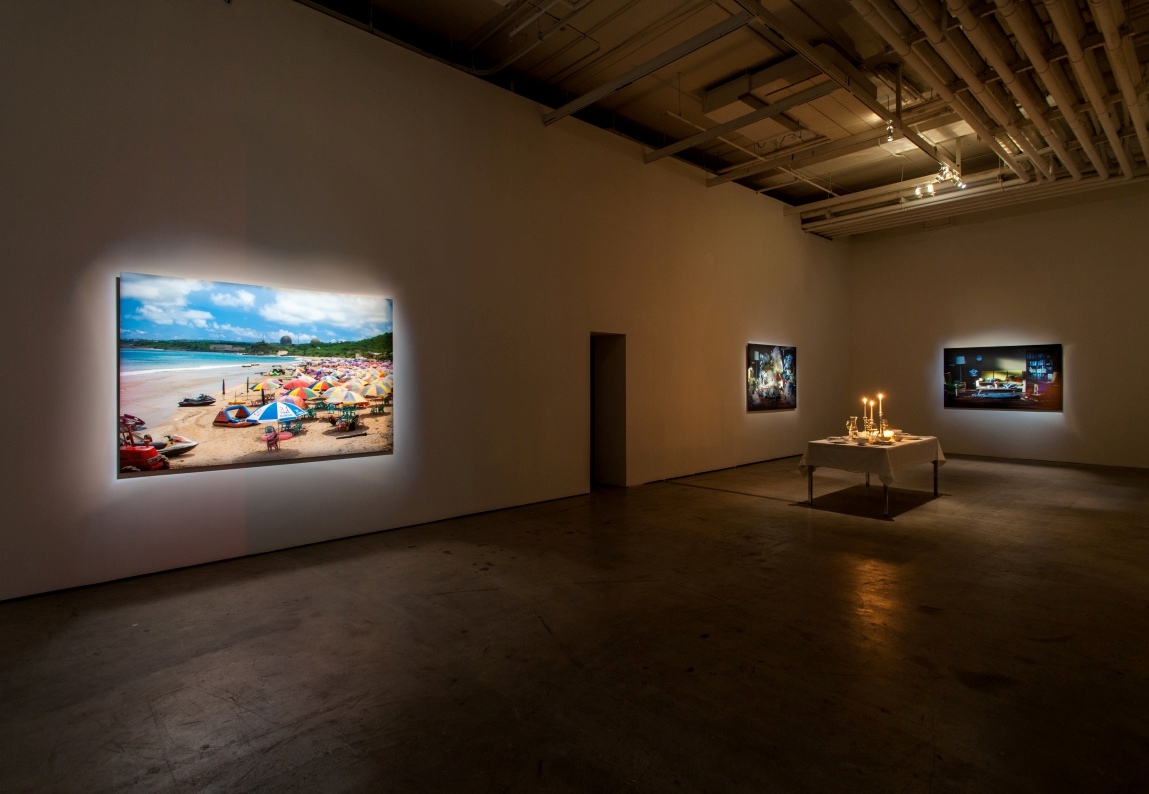「不舒適的明日」,圍繞著當今生存處境,提出人們「棲居何以如詩」的質問。展覽英文標題為「An Uncanny Tomorrow」,”Uncanny”對應德文為”unheimlich”,其詞根“Heim”意為「家」,”unheimlich”意為:沒有像在家的舒適感所產生的憂懼及不安。
單頻道錄像作品《佔領第561小時》以鋼纜直線拍攝的方式,記錄了年輕學子為了更好的明日,佔據立法院議場的畫面,影像緩緩掃描經由後製刪除的無人議場;聖樂般的背景音樂,是播放速度減半的國歌,議會現場頓時化為教堂,瀰漫著神聖犧牲的氛圍,極度冷靜的影像,欲呈現一種比媒體奇觀更為奇觀的場景。動力裝置作品《預言》,不時發出驚嚇、惱人的撞擊聲,如同錄像裝置《指向》,一群身影及臉孔模糊的人們,以食指堅定地指向觀眾,令人有種莫名奇妙或被迫自省的難堪之感,似乎不斷在提醒觀眾,這激烈的反對理由何在?單頻道錄像作品《能量的風景》以空拍的方式,近乎監控般的凝視,讓觀者如臨權力禁區,影像中的冷漠荒涼之感,彷若夢境中所預見的明日廢墟。
無縫循環的影片《棲居如詩》,呈現著IKEA風格中產階級家庭客廳,從無預警的震爆中,才會恍然察覺,這是個水中場景;爆破除象徵著「毀滅」及「重生」,亦隱喻著人類最安全的居住「母親腹中的羊水」。其作品命名靈感來自德國哲學家海德格(Martin Heidegger, 1889-1976)在1951年所給的一篇〈……人詩意地栖居……〉 講稿。海德格對於科技的反思及對自然的敬畏,所謂的天、地、神、人的一種和諧共處狀態,放在現今的現實常態中「棲居難以為詩」。
An Uncanny Tomorrow centers on the present living situations and poses the question of how people can “dwell poetically.” In the English title of the exhibition, An Uncanny Tomorrow, the German equivalent of the English word “uncanny” is “unheimlich,” of which the word “heim” means “home”; therefore, “unheimlich” refers to the sense of worry and anxiety caused by a lack of sense of comfort provided by home.
The single-channel video, The 561st Hour of Occupation, was filmed with the camera on linear cable, recording the occupation of the assembly hall of the Legislative Yuan by groups of young students who were fighting for a better tomorrow. The video slowly pans over the hall, which has been made empty through post-editing techniques. The background music reminiscent of sacred music is actually the national anthem played at half speed, transmuting the assembly hall into a church with its holy, sacrificial ambiance. The extremely tranquil image presents a spectacular scene that had exceeded the media spectacle. The mechanical installation, Prophecy, now then again makes surprising, irritating clashing noise, correlating to the video installation, Indication, in which a group of people with blurry faces persistently point their index fingers to the audience, causing a sense of bewildering embarrassment as if being forced to reflect upon one’s mistakes. It seems to remind the audience to think: what is the reason for the aggravated resistance? The single-channel video, Landscape of Energy, adopts the approach of aerial photography, creating an overlooking gaze suggestive of video surveillance, as if the audience had stepped into the forbidden area of power. The indifferent, desolate feelings in the images remind the audience of the ruins in a future world foreseen in dreams.
The looping video, Dwelling, presents an IKEA-style living room of a bourgeois household. From an unforeseen explosion, one suddenly realizes it is an underwater scene. While the blast symbolizes “destruction” as well as “rebirth,” it also refers to the safest haven of human beings, “the amniotic fluid of a mother’s womb.” The title of this work is inspired by the 1951 speech, “…Poetically Man Dwells…,” given by the German philosopher, Martin Heidegger (1889-1976), in which he expressed his reflection on technology and awe of nature, honoring a harmonious, co-existing state of the sky, the earth, the divinities and the mortals. However, when reviewing the normal conditions in modern reality, it is simply “difficult to dwell poetically.”
袁廣鳴 YUAN Goang-Ming
袁廣鳴生於台灣台北,是早期台灣錄像藝術的先鋒,自1984年開始從事錄像藝術創作,也是目前台灣活躍於國際媒體藝術界中知名的藝術家之一。1997年得到德國卡斯魯造型藝術學院、媒體藝術碩士學位,是台灣少數受過正規完整的媒體藝術訓練的藝術家。目前任教於國立台北藝術大學新媒體藝術學系副教授。
Born in Taipei, Taiwan, 1965, YUAN Goang-Ming is a pioneer of video art in Taiwan. Since working with video in 1984, he has received a Master’s degree in Media Art from the Academy of Design, Karlsruhe (1997). With a background in comprehensive media art training, YUAN is now one of the foremost Taiwanese artists active in the world of international media art. He currently holds a post as Assistant Professor at the New Media Arts program of Taipei National University of Arts.
TKG+
關鍵字
- 錄像裝置
- 爆破
- 家
- 318學運
- 核能
- 環保
- 社會運動
- 廢墟
評審談作品
生命處境的反思。
入圍理由 Reason for Nomination
《不舒適的明日》一展不僅延續袁廣鳴一貫獨特的創作風格與影像美學,在主題上更強化了探究人們日常生活狀態與生活處境的批判性思考,以錄像、動力裝置與攝影等新媒體跨領域的創作形式,透過風格化的視覺語藝及慢動作的影像詩學,將當代關於生存與居住的崩壞、核能災變的寓意、學生運動的指控等議題崇高化。作品以藝術介入並貼近近年來思變的台灣社會脈動,極具時代性格,且能激發觀者更深刻且更為廣泛的人文社會思考,亦呼應了社會公平正義的話語。提名觀察人 ─ 邱誌勇
In the An Uncanny Tomorrow exhibition, YUAN Goang-Ming not only persists in his consistently unique creative style and image aesthetic, but also intensifies his themes of critical thought that explore the conditions and environments of daily life. Contemporary issues that concern the collapse of survival and shelter, metaphors of nuclear crises, and accusations in the student movement-- are elevated using a variety of new media and interdisciplinary creative methods including recorded images, mechanical installations, and photography in a stylized visual lexicon and slow motion visual poetics. The works approach and penetrate changes in Taiwan’s social trends in recent years. They characterize the era and stimulate the depth and breadth of socio-cultural contemplations in the viewer, resonating with the call for social justice. Nominator: Chih-Yung Aaron CHIU
年度入選獎得獎理由 Jury’s Statement on Award Winners
影像技術的研究與批判如何成為生命處境的反思。從早期存在主義式的「困頓」、「懷疑」,袁廣鳴的「不舒適的明日」把問題擴延至家國現實。影像薄膜的崩壞、展覽現場的身體警覺意識,與日常空間的災異戲劇性,「不舒適的明日」使關於現實的質問,成為影像與視覺展演美學上思辨的對象,而不僅只是議題的選擇。藝術家以錄像、動力裝置與攝影等不同媒介,成功透過風格化的視覺語彙及影像詩學,將當代關於生存與居住的崩壞、災難的寓意、社會運動中的場域與影像媒介之間的社會關係,凸顯出來。影像即便是「奇觀」的,藝術家終究提醒尚有不可見的縫隙在不斷逝去的時間當中。
The research and critique of imaging technology becomes a reflection on conditions of everyday survival. YUAN Goang-Ming’s work, An Uncanny Tomorrow, extends the question from previous existentialist “distress” and “doubt” into the national reality. Through the corrosion of image veneers, the vigilant physical consciousness at the exhibition site, and the ominous dramatics of quotidian spaces, An Uncanny Tomorrow questions reality as an object in the contemplation of images and visual performance aesthetics beyond a mere thematic choice. Through a stylized visual lexicon and image poetics, the artist applies a multitude of media—including recorded images, mechanical installations, and photography—to successfully highlight the collapse of survival and shelter, the parables of disaster, and the social relationship between the sites of social activism and mediating images. Images become “spectacle” and the artist ultimately reminds us of the unseen fissures that exist in endlessly elapsing time.






